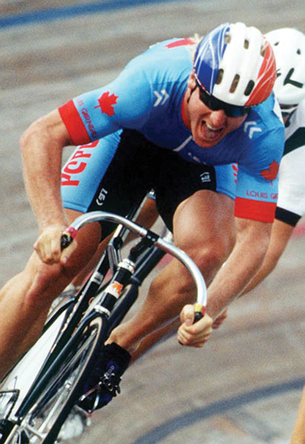Module 6 Intro
1. Module 6 Intro
1.1. Big Picture
Module 6—The Motor System and Homeostasis
 Big Picture
Big Picture

Courtesy Archives Canada
As you saw in Unit C, the energy supply for the activities that power people’s bodies includes aerobic and anaerobic cellular respiration. In this module you will look at the link between these processes and muscle contraction.
In one of the greatest moments in Canadian sport history, Simon Whitfield won the gold medal in the triathlon at the 2000 Summer Olympics in Sydney, Australia. The triathlon is a grueling combination of swimming, cycling, and running and is the ultimate test of speed, strength, and endurance.
Whitfield went into the race as Canada’s lone hope in the men’s triathlon. Leading up to the games, he had finished no higher than seventh in previous world championships. He defied all odds, even overcoming a crash in the cycling portion of the event and pulled away from the field in a final 500-metre sprint to the finish.
As Whitfield propelled himself around the triathlon course he used a variety of muscles and converted the stored chemical energy in their cells into kinetic energy. During this conversion, a tremendous amount of energy was also converted to heat. How did Whitfield’s motor system propel him toward victory?
As you will see in all of the body systems in Unit D, when faced with stresses a variety of difficulties and disorders arise. In this module you will also investigate specific muscle disorders, as well as the effects of the underuse and overuse of muscles.
You will see the importance of training and exercise on muscle health. You will also consider the interaction of the muscular system and other body systems. What is the role of the muscle system?
To support the exploration of the role of the motor system, you will explore the following essential questions:
- How does the motor system support and interact with other body functions, including digestive, circulatory, respiratory, and excretory systems?
- How are the roles of cardiac, smooth, and striated muscles different?
- How do specialized structures in muscles cause muscle contraction?
- What is the relationship between energy use by muscle cells and heat production?
- What are the main complications of the muscular system, and what technologies can be used to treat these conditions?
Throughout this module, you will interpret information that can be used for your module project. Do not begin creating your project at this time. Your project, which investigates mitochondrial myopathy, will be submitted at the end of the module as the final module assessment. You will be submitting a unified response, much like you would complete on a diploma exam. For detailed instructions and the evaluation criteria, visit the module assessment section.
As you work through the module, make note of questions or concepts that were particularly challenging or thought provoking. This list will be helpful when you are ready to start the unit assessment. You will be researching a disorder that disrupts a body system. You may want to do more research on something you investigated in your module projects or research a topic that you find interesting. You will find the details for this assessment and an evaluation rubric in the Unit Assessment portion of the Unit Summary.